Getuar Rexhepi
Blinding the Wiretapper: RIS-Enabled User Occultation in the ISAC Era
Apr 21, 2025



Abstract:An undesirable consequence of the foreseeable proliferation of sophisticated integrated sensing and communications (ISAC) technologies is the enabling of spoofing, by malicious agents, of situational information (such as proximity, direction or location) of legitimate users of wireless systems. In order to mitigate this threat, we present a novel ISAC scheme that, aided by a reconfigurable intelligent surface (RIS), enables the occultation of the positions of user equipment (UE) from wiretappers, while maintaining both sensing and desired communication performance between the UEs and a legitimate base station (BS). To that end, we first formulate an RIS phase-shift optimization problem that jointly maximizes the sum-rate performance of the UEs (communication objective), while minimizing the projection of the wiretapper's effective channel onto the legitimate channel (hiding objective), thereby disrupting the attempts by a wiretapper of localizing the UEs. Then, in order to efficiently solve the resulting non-convex joint optimization problem, a novel manifold optimization algorithm is derived, whose effectiveness is validated by numerical results, which demonstrate that the proposed approach preserves legitimate ISAC performance while significantly degrading the wiretapper's sensing capability.
Quantum Manifold Optimization: A Design Framework for Future Communications Systems
Apr 13, 2025
Abstract:Inspired by recent developments in various areas of science relevant to quantum computing, we introduce quantum manifold optimization (QMO) as a promising framework for solving constrained optimization problems in next-generation wireless communication systems. We begin by showing how classical wireless design problems - such as pilot design in cell-free (CF)-massive MIMO (mMIMO), beamformer optimization in gigantic multiple input multiple output (MIMO), and reconfigurable intelligent surface (RIS) phase tuning - naturally reside on structured manifolds like the Stiefel, Grassmannian, and oblique manifolds, with the latter novelly formulated in this work. Then, we demonstrate how these problems can be reformulated as trace-based quantum expectation values over variationally-encoded quantum states. While theoretical in scope, the work lays a foundation for a new class of quantum optimization algorithms with broad application to the design of future beyond-sixth-generation (B6G) systems.
Tone Reservation-Based PAPR Reduction Using Manifold Optimization for OFDM-ISAC Systems
Sep 24, 2024

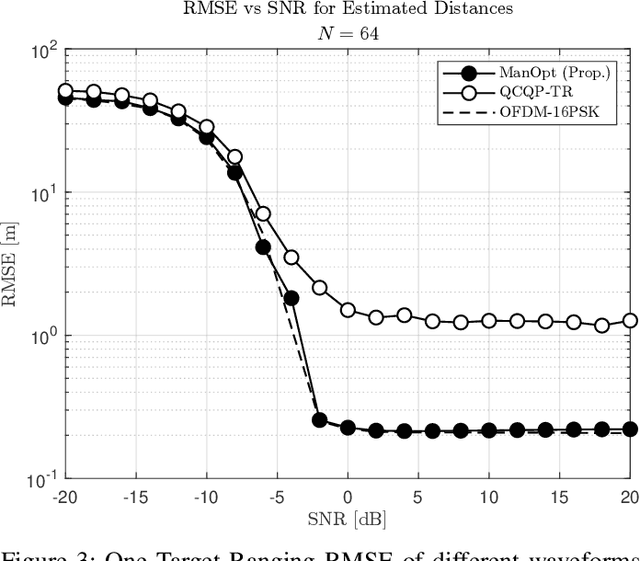
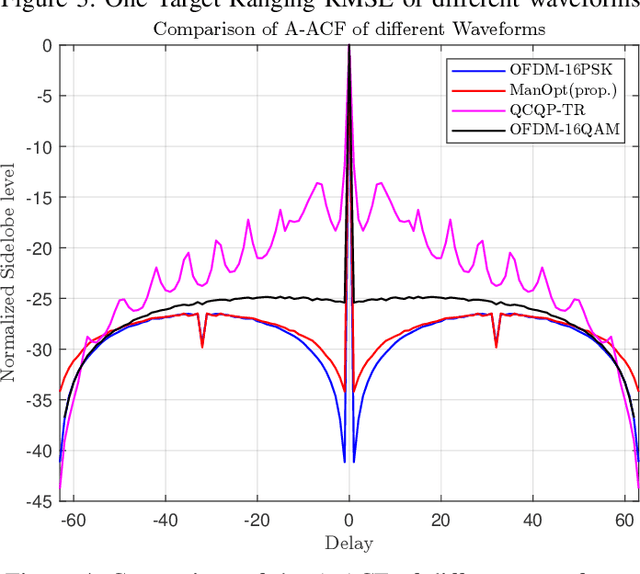
Abstract:We consider the peak-to-average power ratio (PAPR) reduction challenge of orthogonal frequency division multiplexing (OFDM) systems utilizing tone reservation (TR) under a sensing-enabling constraint, such that the signals placed in the reserved tones (RTs) can be exploited for Integrated Sensing and Communication (ISAC). To that end, the problem is first cast as an unconstrained manifold optimization problem, and then solved via an iterative projected gradient descent algorithm assisted by an approximation of the infinity norm. Simulation results show that the proposed method, while maintaining a level of PAPR reduction similar to state of the art (SotA), not only has lower computational complexity but also outperforms the alternatives in terms of sensing performance.
Optimized Tone Reservation for Opportunistic OFDM Communications and Sensing
May 06, 2024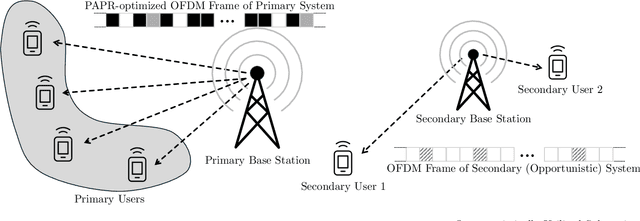
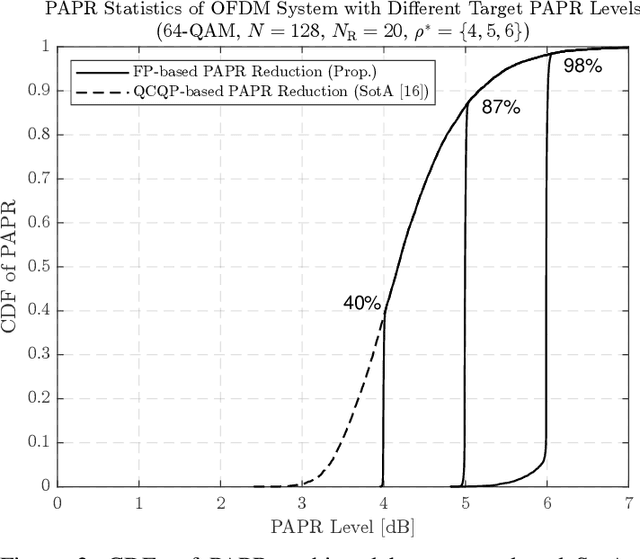
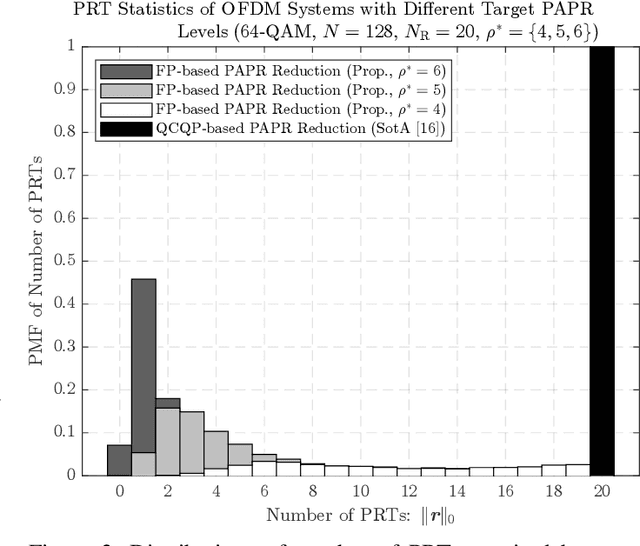
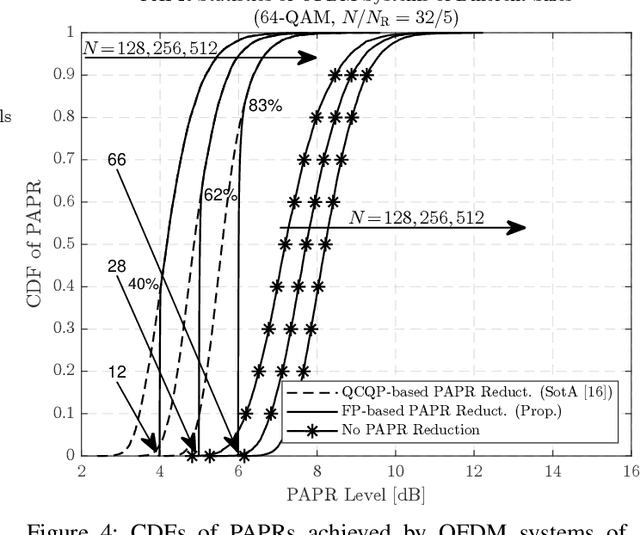
Abstract:We consider the problem of peak-to-average power ratio (PAPR) reduction in orthogonal frequency division multiplexing (OFDM) systems via optimized sparsification of tone reservation (TR). In particular, we propose a novel TR optimization method in which the minimum number of effectively used peak-reserved tones (PRTs) required to satisfy a prescribed PAPR level is found, leaving the remaining PRTs free to be opportunistically utilized by other functionalities, such as joint communication and sensing (JCAS), index modulation (IM), cognitive radio (CR) and others. The proposed method relies on an l0 norm regularization approach to penalize the number of PRTs, leading to a problem convexized via fractional programming (FP), whose solution is shown to ensure that the prescribed PAPR is achieved with high probability with a smaller number of PRTs than state of the art (SotA) methods. The contribution can be seen as a mechanism to enable the opportunistic integration of adjacent functionalities into existing OFDM-based systems.
 Add to Chrome
Add to Chrome Add to Firefox
Add to Firefox Add to Edge
Add to Edge